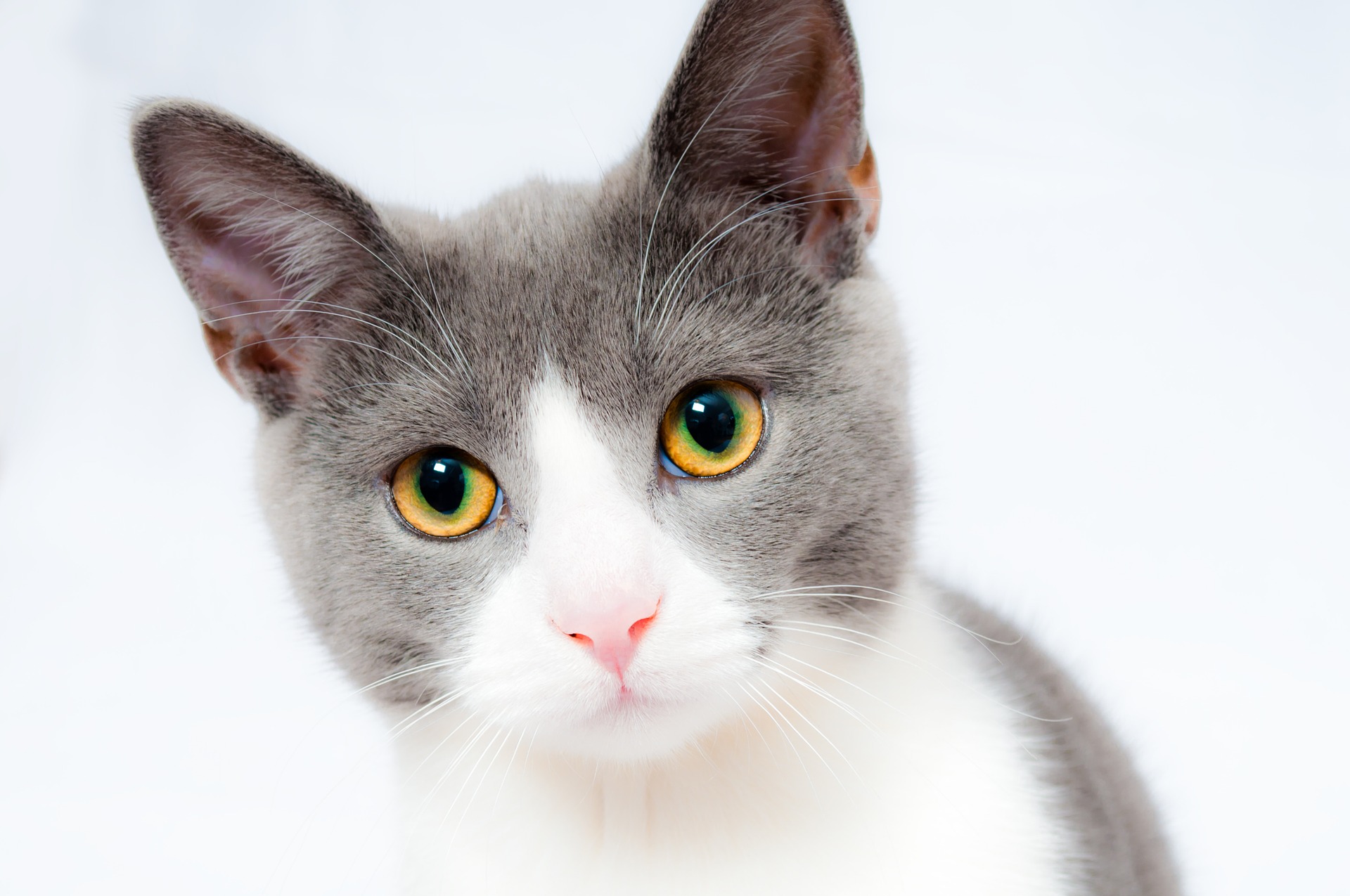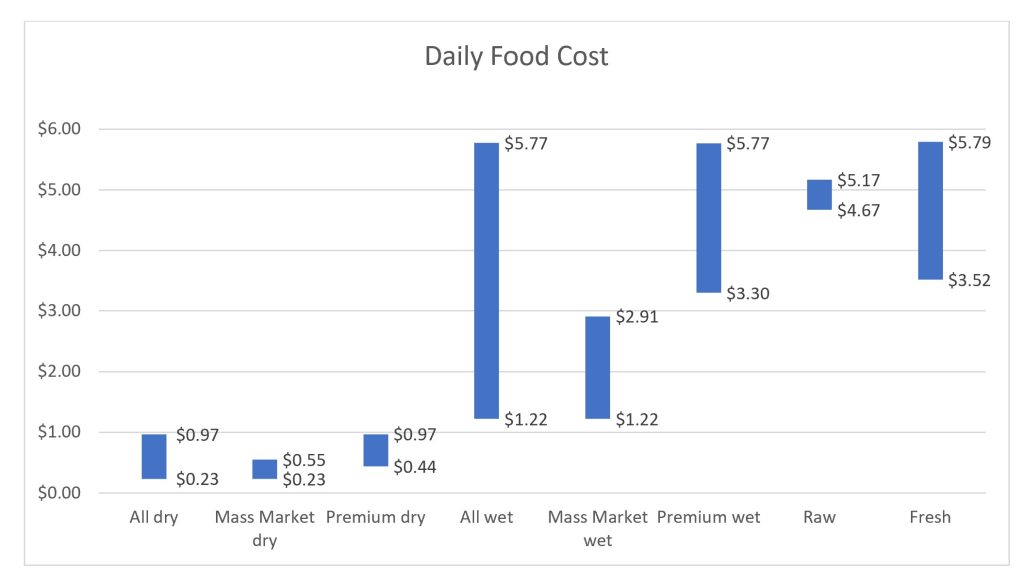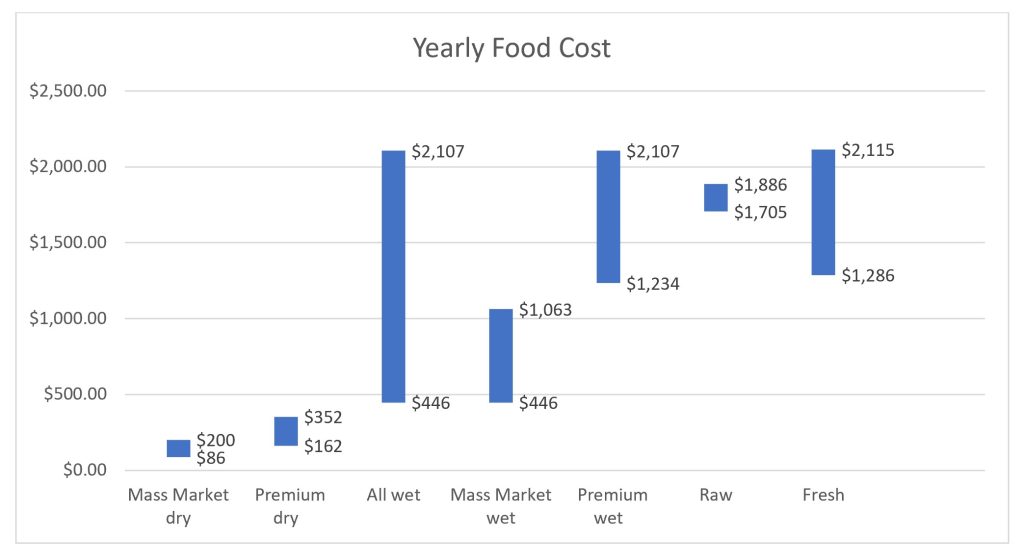
the scientific study of pet nutrition by veterinary nutrition specialists and experts.
Comparing kitty’s calorie costs

I previously posted on the costs of feeding various types of commercial dog foods: dry foods, wet foods (cans, pouches, tubs), fresh food (cooked and purchased fresh or frozen), and raw (freeze-dried). The costs of feeding of each type of dog food varied dramatically – the range was $201 to > $7,000 per year! So, of course cat foods deserved a similar treatment.
Cat foods are typically more expensive than dog foods on a per pound basis because they are usually higher in protein and fat (which are more expensive ingredients) than similar dog foods.
Where did these data come from?
To get a better sense of current cat food expenses, I collected some data on the cost to feed certain types of cat foods to a hypothetical cat – a 10lb (4.55 kg) kitty needing a very average 260 kcal (1 kcal = 1 “human” Calorie) from food each day to maintain weight. I selected at least 3 diets from each category:
- Dry and wet mass market foods (these are foods available at stores like Walmart or Target, and grocery stores)
- Dry and wet “premium” diets (these are foods available at large pet chains and pet boutiques)
- “Fresh food” diets (these are generally purchased on a subscription basis online directly from the manufacturer but can be purchased frozen at some local retailers)
- Raw diets (I chose freeze-dried raw because they are shelf stable and sold at similar stores to the dry and wet foods). Note that we do not recommend raw feeding because of health risks to pets and people!
As for the dog foods, I picked diets that represented well-known, popular foods in each category, trying to select those that I perceived to be some of the most popular diets at the bottom, middle, and top of the price range that I’ve seen for the category. I gathered pricing info from the websites of the stores where the diets would generally be purchased. I based the dry food prices on the bag closest in size but not exceeding 7lb, as this is a common size to purchase for a one cat household. For wet foods, I based my calculations on cases of 24 when available, rather than individual cans or tubs, and always the bigger size if more than one was available (typically 5-6 oz). When possible, I selected the same brand of dry and wet food in each category for a more direct comparison.
I selected only foods marketed for adult cats (kitten foods are often more expensive) and stuck with chicken or “original” flavors, to avoid increased costs from exotic meats or other ingredients and to allow for a better comparison. When possible, I selected the same or similar brands as I selected for the dog foods in my previous post. All of the products were at their typical price, none were on sale. For the fresh food products, I assumed a purchase large enough to result in free shipping.
How much can one expect to spend on the different types of cat food?
Here’s what I found in terms of costs to feed the average 10lb cat:
The daily costs ranged from 23 cents to nearly $6 for the same amount of calories! All of the dry foods, even the most expensive, were still cheaper per day than the least expensive canned foods. There was some overlap in cost between the mass market and premium dry foods, but not between the mass market and premium wet foods.
The yearly costs ranged from $86 to over $2,100 – a pretty dramatic range! Dry diets were by far the least expensive option, even though I included one of the most expensive mainstream dry foods. Fresh foods and raw foods were generally more expensive than both dry and wet foods. Surprisingly, and very different from what I saw in dogs, the premium wet food was more expensive than the raw foods and very similar to the fresh foods. (For the dogs, fresh food was more expensive than all canned and dry foods and raw was the most expensive type of food, costing a minimum of twice the cost of premium wet food and more than even the most expensive fresh foods.)
There are obvious limitations to this data – the dry and wet include only 6 products each, while the raw and fresh foods only 3 major brands. All were hand-picked by me to be widely available and well-known rather than being randomly selected. However, I think the selected diets are pretty representative of their categories based on my decade of experience working as a clinical nutritionist. There are definitely products available that are less and more expensive in each category than these examples, but they are generally going to be less common and less available. I think these ranges give you an idea of what you can expect to spend right now to feed an average adult cat the various food types.
Does a higher price = better health?
The obvious question to ask here is whether the higher cost is justified by better health for the cat. All of the diets that I used were “complete and balanced” meaning that they are unlikely to lead to any nutrient deficiencies and should be at the very minimum “adequate” diets to promote overall health. I would feed any of the lower priced dry and wet diets to my own pet if I needed an economical option, so these weren’t diets with questionnable quality. Higher moisture diets may have benefits for some cats, especially those with certain health conditions, but the difference in cost is pretty dramatic.
While many pet owners who feed more expensive diets of all types report improved health in their pets, these results likely represent the “marketing placebo effect” – when we spend a lot of money on something, we have a vested psychological interest in convincing ourselves that it was good value! There are minimal scientific data to suggest a benefit of fresh or raw diets versus dry or wet for an otherwise healthy cat. In fact, there is plenty of evidence of potential health risks from raw diets, for both the cat and the cat’s family, despite this being a more expensive way to feed.
I encourage all cat lovers to select diets for their cats that fit comfortably into their family budgets. There is a good quality diet available at nearly every price point for a healthy cat. Your veterinarian can help you sort out the best diets from the most heavily marketed so that you get a healthy diet that’s a good value for your money, regardless of your budget.
Feature image by scott payne from Pixabay
Want to read more information on feeding your pet?
Subscribe to always know when we add new material!
Recommended Posts

Can Diet Help With My Dog’s Seizures?
January 18, 2024

The Most Popular Holiday Foods…That Your Pet Should Avoid!
December 08, 2023

Veterinarian Recommended Pet Foods: What You Need to Know
November 05, 2023


